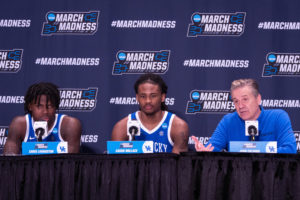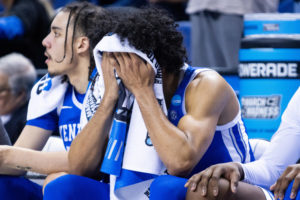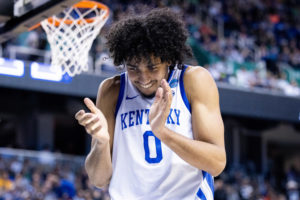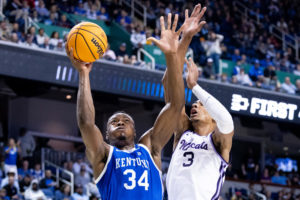COLUMN: Kentucky mens basketball’s Kansas State loss marks full-circle moment for program
Kentucky Wildcats head coach John Calipari speaks to reporters after the No. 6 Kentucky vs. No. 3 Kansas State mens basketball game in the second round of the NCAA Tournament on Sunday, March 19, 2023, at Greensboro Coliseum in Greensboro, North Carolina. Kansas State won 75-69. Photo by Samuel Colmar | Staff
March 26, 2023
Kentucky mens basketball’s 2023 NCAA Tournament loss to Kansas State was undeniably disappointing based on the flow of the game up to that point, but the matchup against K-State also signified an important benchmark for a much larger issue for the team.
Looking back in history just a few years ago, many members of Big Blue Nation with a keen memory will recall that the 2023 edition of the “big dance” wasn’t the first time the Cats had lost to the other Wildcats in the tournament. In fact, it wasn’t even the first time in the last five years.
Fresh off of an Elite Eight loss to eventual national champions North Carolina in 2017, Kentucky Wildcats fans were eager with anticipation heading into the 2017-18 season.
The Cats had a stacked roster of current NBA talent including Shai Gilgeous-Alexander and P.J. Washington, along with names like Kevin Knox, Hamidou Diallo and Nick Richards.
Kentucky finished its regular season with 10 losses, a less than stellar season for a team projected as No. 5 preseason. Sound familiar?
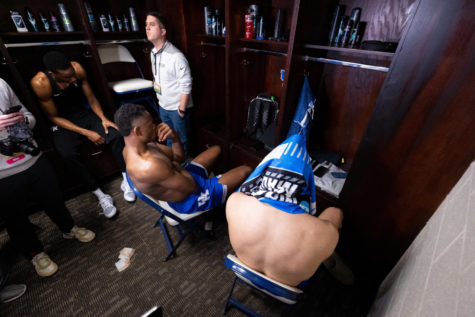
Surprisingly though, Kentucky won the SEC Tournament in impressive fashion, earning itself a No. 5 seed in the NCAA Tournament. Once again, sound familiar?
Kentucky had a seemingly tough bracket section, but it quickly opened wide up with No. 1 Virginia becoming the first ever top seed to lose to a No. 16 seed, falling to UMBC.
To make matters even better for Kentucky, No. 2 Cincinnati was upset in the second round by No. 7 Nevada, No. 3 Tennessee was upset by No. 11 Loyola Chicago and No. 4 Arizona was defeated by No. 13 Buffalo.
Kentucky went from fifth on the totem pole to the top dog in its bracket in just one weekend.
As many fans remember though, it would be No. 9 Kansas State that conquered the Wildcats in the Sweet Sixteen by just three points before K-State itself would then also be upset by Loyola Chicago.
Looking to rebound in 2018-19, Kentucky, this time supported by names such as Tyler Herro, Ashton Hagans and Keldon Johnson, Kentucky finished the regular season ranked No. 6 in the country and earned a No. 2 seed in the NCAA Tournament.
While the year did produce an Elite Eight performance, many Kentucky fans once again felt burned when the Cats were upset by No. 5 Auburn.
Kentucky once again finished the 2019-20 season ranked No. 6 nationally and were crowned SEC champions, but the year would quickly be for not as the NCAA Tournament was canceled entirely due to the onset of the COVID-19 pandemic. The decision was a disappointing one for numerous Kentucky fans who felt as though the team may have had a run in it.
After that, disaster struck.
It was the 2020-21 season that saw the Cats finish 9-16 and miss the NCAA Tournament entirely before the 2021-22 season somehow reached an even lower point for many fans.
Entering the tournament with real national championship ambitions, a Kentucky team that had been battered by injuries and may have begun to rely far too heavily on reigning consensus National Player of the Year Oscar Tshiebwe was stunned in the first round by No. 15 Saint Peter’s.
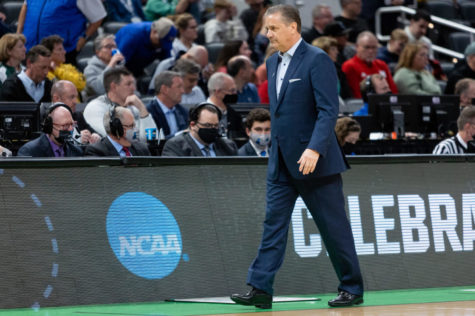
In the end, it had been poor performances from previously injured players and an inability to run an offense beyond just Tshiebwe that led to the Cats’ downfall.
Heading into this season, similar to the 2017-18 season, Kentucky had high expectations, being ranked No. 4 in the preseason before once again losing 10 games in the regular season.
While Kentucky didn’t win the SEC Tournament, it did enter the NCAA Tournament with a similar seed line, being placed as the No. 6 team in the Eastern Region.
The Wildcats once again took care of their first opponent, this time Providence, but the aforementioned game against Kansas State led to heartbreak once again for Kentucky fans.
Similar to the year prior, Kentucky had its Achilles heel that led to its downfall, only this time it was inconsistency from its key offensive pieces and lack of a multifaceted 3-point attack.
While it may be stating the obvious to say that a team with an obvious weakness is doomed to fail in the tournament, that has been Kentucky’s downfall in the past two seasons.
Even further, looking at the fan reaction to head coach John Calipari back in 2018 as opposed to now, it’s clear that the years in between have not been kind to Kentucky basketball.
While the records, wins and losses, seeding and round of exit were all different between the two years, they’re just similar enough to raise some eyebrows and even to suggest that, simply put, Kentucky has hardly evolved in the five years since the loss and, arguably, it has even regressed.
Whether or not the stretch will simply mark the awkward middle years of the program under Calipari or the beginning of the end we simply won’t know for years to come, but the cyclical nature of the results is certainly worth at least a mention and perhaps even a warning for the program itself.































































































































































